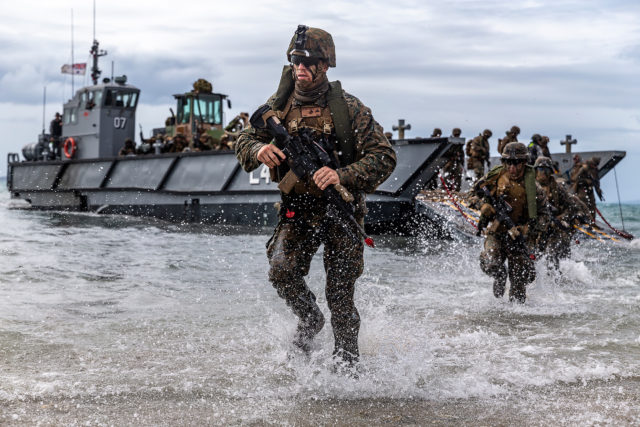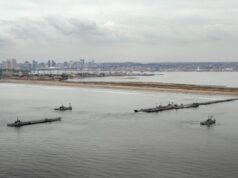
Commandant of the Marine Corps General David Berger’s “Force Design 2030” has caused quite a stir. The document envisages a shifting of the Marine Corps from a “Second Land Army” force to a “commando-like infantry force with nimbler weapons: drone squadrons will double and rocket batteries will triple.” There is more, much more. Force Design 2030 has its supporters, including Secretary of Defense Mark Esper, and there is certainly support in the active duty Marine Corps, an organization noted for its historic loyalty to the Commandant. There are, however, skeptics within active duty ranks and the large population of former Marines, retired and otherwise.
All things considered, it is a subject definitely worth discussion.
The underlying purpose is to draw closer to the Navy by assisting in gaining control of the South and East China Seas in the event of war against China. The heavily wargamed FD 2030 Concept of Operations envisages the change of infantry regiments to “Littoral Regiments.” Simply stated, the Littoral Regiments would be organized, trained, and equipped to infiltrate small units (50 to 100) Marines ashore on any of the multitude of islands available in both seas.
Also to be smuggled ashore would be long range anti-ship missiles. The missiles, located in commercial shipping containers, would be transported to hiding places by rented civilian trucks. The Marines and their equipment would remain separate from the population. When needed by the Navy, the Marines located on the appropriate island would be notified of the targeted ship and its location. The Marines would then move the missile from its hiding place to its launching location, activate the targeting and launching systems, and sink the Chinese target.
What China Knows
Chinese activity in the information collection business has been the topic of many news reports. China has a finger in every pie, including, of course, the U.S. military. There is no rational reason to assume that Chinese are not now, or will not soon be, quite familiar with Force Design 2030 and its stealth mode of operation, including shipping container involvement.
We have learned that shipping container operations are much more complex than one might think. Locals must be involved, especially if the containers are to be brought to small islands by smaller container ships. Arrangements must be made for discharging and delivering the containers and needless to say, there is the required inspection of the container contents. The system is fraught with security loopholes.
Information surrounding the eventual introduction of two Light Amphibious Warfare Ships implies that these ships would be used to load, transport and offload missile containers. What is not addressed is how this could be done without Chinese knowledge of the ships’ ownership and the cargo. Considering the Chinese interest in controlling the China Sea islands, it would be interesting to learn how the wargames work around the loopholes in a vulnerable container accounting and handling system that includes customs inspections.
The commercial container operation is complicated, involving among other details, a customs inspection at the receiving port or beach. The container system is vulnerable to security leaks and inevitable exposure.
The Economic Context
Money counts, but no published writings examining FD 2030 within the context of Chinese and American economic situations have been found.
China today is using economic power to acquire control of, among other things, world supply chains, manufacturing, businesses, distant seaports, and merchant shipping lanes. And if those are not enough, we have been too placid about the obvious copying of American military and naval equipment, including aircraft and ships.
China had been running amok until her progress was slowed during the past few years by the imposition of tariffs and other measures to stop economic outrages such as theft of American intellectual property. Prior to the coronavirus pandemic, there were signs that America’s actions were having an effect. Predictions that China’s economy was headed for trouble had become commonplace. China’s pandemic behavior has caused itself even more problems. For example, The Voice of Europe publication recently noted that Britain, the European Union, the U.S. and Japan are taking measures to break the stranglehold Communist China has on the world’s supply chains by bringing home businesses from China, “… unelected Communist Party bigwigs are said to be in a state of panic.”
Should that exodus of businesses occur, China’s power would be greatly diminished and the need for focus on the China seas dramatically reduced.
Meanwhile, America has spent years helping the Communist Chinese become a dominant world economic power. During that process and others, the American national debt became astronomical and is growing. It is now somewhere north of $25 trillion and destined to grow to even greater levels as the government spends trillions more fighting the economic effects of the coronavirus pandemic shutdown and the need to help finance the return of companies to the United States.
Adding more gloom to that financial situation is the fact that there are those in Washington eager to spend trillions more on such socialist dreams as the Green New Deal, government-controlled health care, free college tuition for all, reparations for slavery, and of course, the ever present “need” to bail out states that have been mismanaging funds, budgets, and retirement benefits for state employees for years. Not satisfied with those fiscal adventures, Washington is also considering as much as a $3 trillion second round of post-coronavirus financial programs.
Recently, a group of legislators wrote that government spending during the coronavirus must stop because it is closing in on $10 trillion. They noted that, adjusted for inflation, $10 trillion is more money than was spent on the Revolutionary War, Civil War, World War I, and WWII combined.
And given America’s dangerously large and mounting debt, the nation’s political class must eventually start looking for new money sources. Prime targets will be the national defense in general and a Marine Corps organized and trained to fulfill something other than the force in readiness mission so useful to the nation in particular.
In brief, the two major powers competing for world economic leadership are now each facing a harsh economic situation. It is in that context that the changes should be examined.
A Product of Wargames
FD 2030 is the product of a series of wargames. Nothing has been reported about the wargames themselves, but much has been reported about changes to be made in the Fleet Marine Force (FMF), a force that purportedly will still be able to serve as the nation’s rapid reaction “force in readiness,” even though it is organized, trained and equipped to serve as a “commando-like” sea control force.
In addition to losing its tanks, the FMF’s infantry loses an entire regiment plus 200 Marines from each of the 21 remaining infantry battalions. The rifle companies gain many more Staff NCOs, (common in commando structures); company weapons platoons will no longer exist; the machine guns and Mk-19 grenade launchers will be unmanned but located in an armory for use at the battalion commander’s discretion; and the rifle company’s 60mm mortars will become a thing of the past. Cannon artillery is reduced to only 5 batteries in the entire FMF. Cannons will be replaced by rockets, missiles, and drones. Considering the organizational changes and the mission requiring stealth, the “Littoral Regiments” are commando forces or, in American terms, “Special Operations Forces” organized, equipped and trained to perform a special operations stealth mission.
Marine Aviation
Published descriptions of the FD 2030 mission do not include Marine aviation.
An official FD 2030 document of March 2020 does state that there will be “… some carefully constrained tests of the ability of the F-35B (a VSTOL aircraft) to operate from austere, undeveloped landing sites.” As stealth aircraft, the F-35B and C models are the ideal weapons systems to close within missile range of warships and successfully attack. Unfortunately, the F-35B needs a reinforced pad for vertical landings and a short runway for takeoff. The F-35C, designed for aircraft carrier operations, needs a minimum 4000-foot runway for take-offs and a mid-runway arresting gear for landings. Use of either F-35 model in a FD 2030 deployment role seems impractical.
The Marine Corps, as the nation’s 911 force in readiness, is prepared to deploy lethal forces on short notice. These contingencies, not war with China, are the most common types of emergency deployments. For decades, the Marine Corps’ response has been provided by Marine Air Ground Task Forces (MAGTF’s) of the size and composition required. One of the prices of FD 2030 is the loss of the MAGTF capability. An organization structured, trained and equipped to conduct commando stealth operations cannot be converted into a MAGTF warfighting machine on short notice.
The FD 2030’s 26 percent Marine aviation loss includes losses of all types of aircraft except KC-130 refuelers, a much-needed aircraft even today. Marine aviation is the MAGTF’s Close Air Support hammer and source of ground force battlefield mobility. FD 2030 Marine aviation lacks the pile driver punch and mobility assets required by MAGTF’s. For example, current plans call for the 18 active duty Marine F-35B squadrons to each have 16 aircraft. FD2030 reduces that number to 10 aircraft per squadron – a total planned decrease from 288 aircraft to 180 aircraft.
The F-35B and C model stealth aircraft are expensive, ideal anti-ship weapons systems. They are the best and most efficient weapons system in the Corps today. Both can perform the FD 2030 mission without having 50-100 man detachments deployed to China Sea islands. The C model planes operate from carriers. The challenge would be to find safe bases and tanker support for the B models or F-35C’s not carrier-deployed. There is no need to deploy small groups of Marines to China Sea islands.
Conclusion
Writing in Foreign Policy, Tanner Greer posited three questions for the developers of FD 2030:
Was this plan developed in consultation with America’s Indo-Pacific allies or with the other branches of the U.S. military, all of whose cooperation is needed for its success?
Is the Marine Corps optimizing itself for the range of possible conflicts with China, or just the one it most wants to fight?
What if the Marine Corps’s predictions for the future are wrong?
We suspect none of those were asked or answered. The FD 2030 mission is actually a special operations mission. The nation has a Special Operations Command. It does not need the overhead attendant to a second Special Operations Command; Money counts.
The FD 2030 force is not organized, trained or equipped to perform the most likely types of force in readiness combat missions. These require MAGTF capabilities not available in light of the required reorganizing, re-equipping and training involved in converting from a defensive to offensive role.
America is a maritime nation and in order to protect her maritime interests, must have the ability to project power from the sea. Sadly, that power has been permitted to atrophy. A concerted Navy-Marine Corps effort of value to the nation would be the modernizing of amphibious warfare doctrine, equipment, shipping and training. These are necessary actions that must be taken, even though money counts.
Otherwise, we are not dealing with a new beginning of the Fleet Marine Force. We are likely seeing the beginning of the end of the United States Marine Corps. First, Marine Air: then the rest.
Maj. Gen. Michael Sullivan, USMC (Ret.) and Maj. Gen. Jarvis D. Lynch, Jr., USMC (Ret.)





